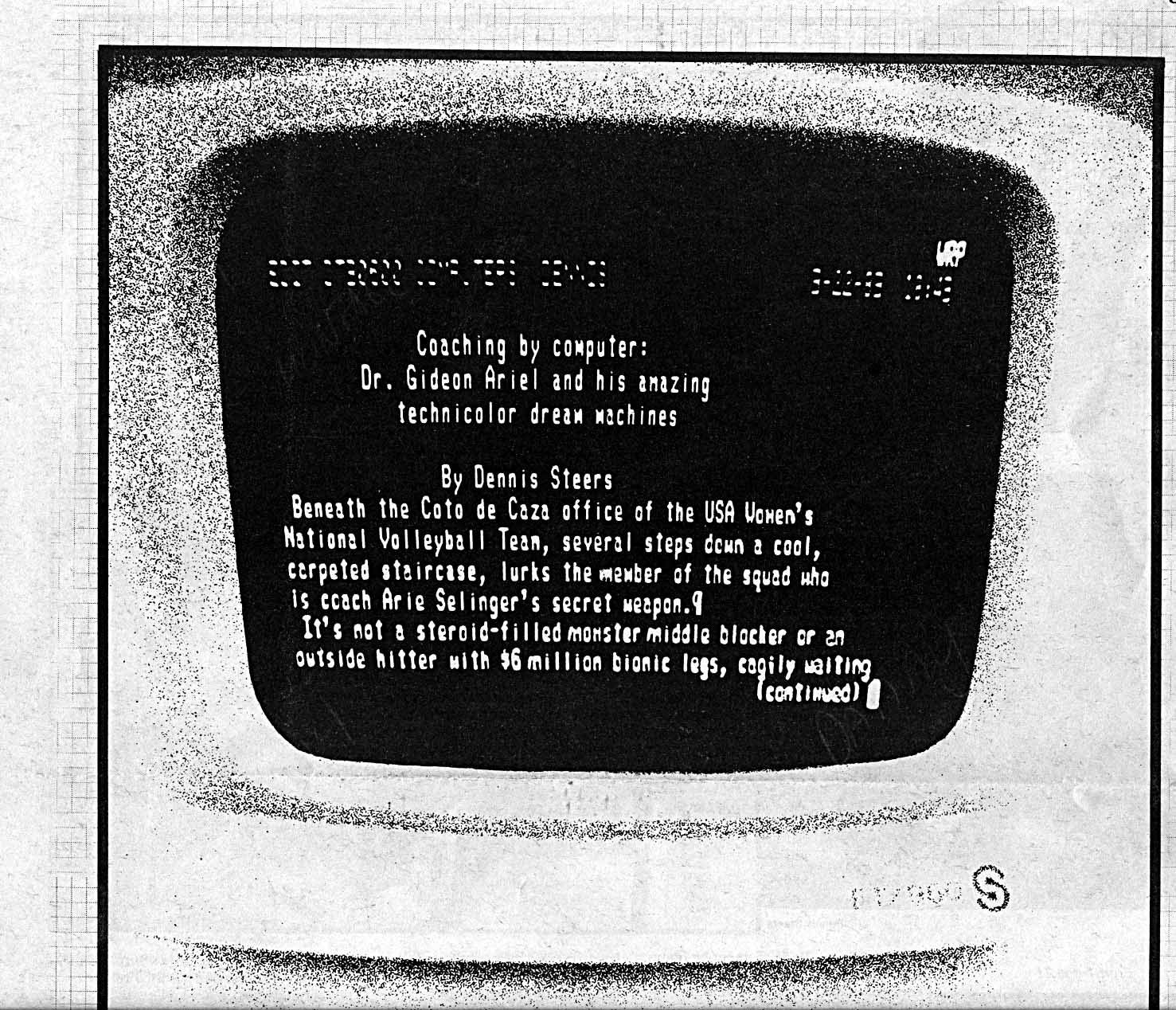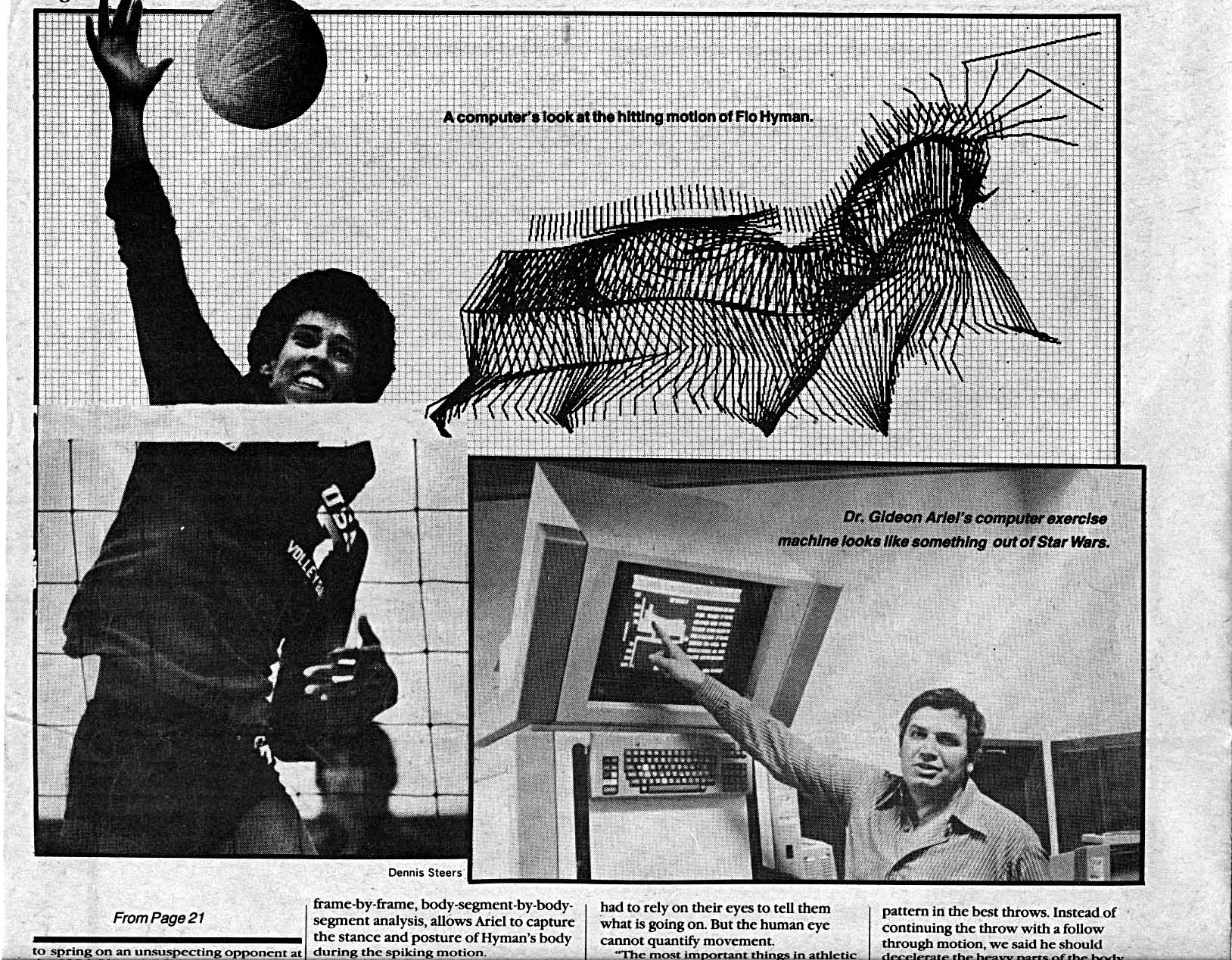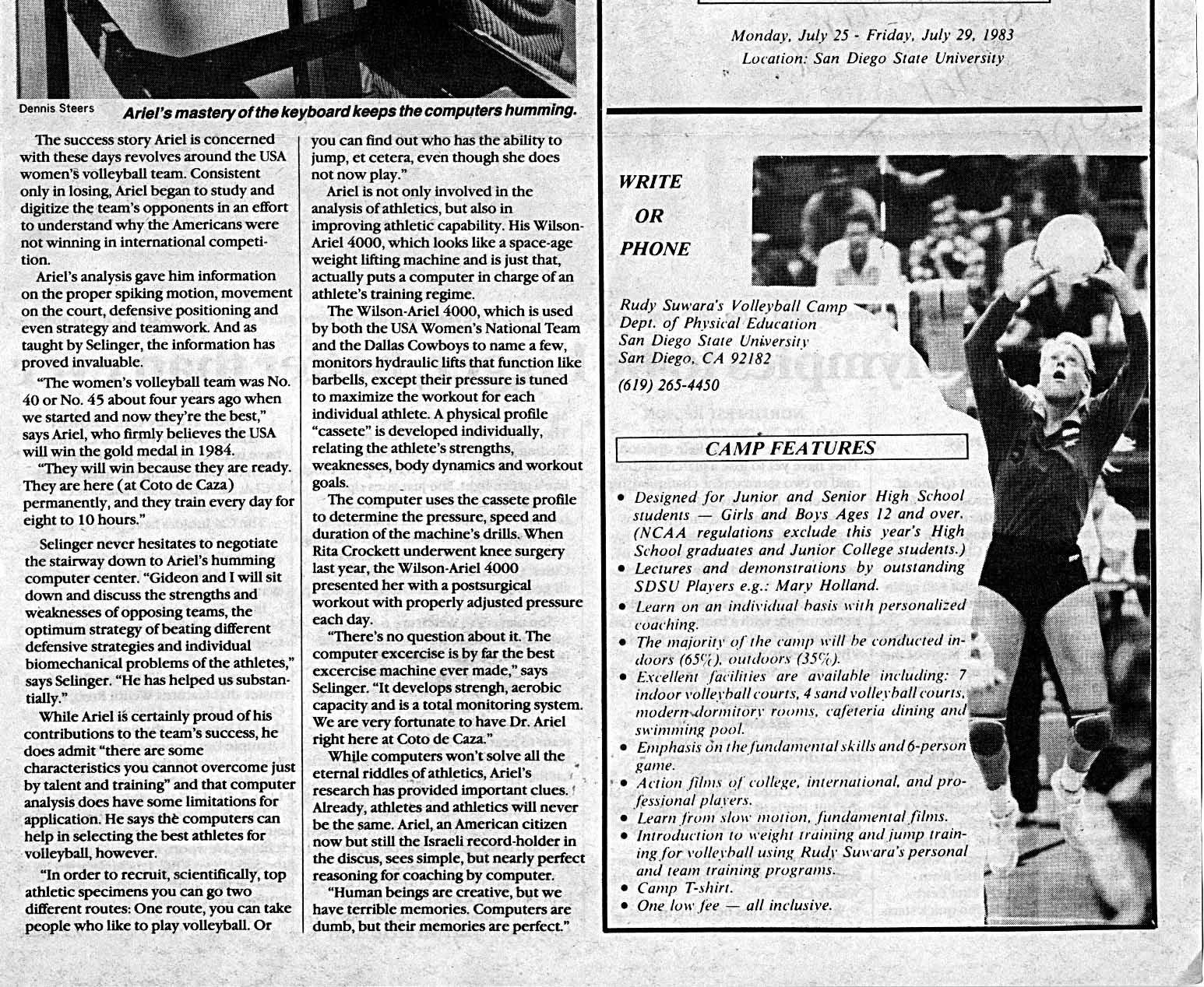Coaching by Computer
Frame-by-frame, body-segment-by-body-segment analysis, allows Ariel to capture the stance and posture of Hyman's body
By Unknown in Volleyball Monthly on Friday, April 1, 1983
Dr. Gideon Ariel, president of Computerized Biomechanical Research, uses advanced technology to analyze and improve athletic performance. Ariel uses cameras, high-speed film, digitizing screens, magnetic pens, and computer graphics to study the mechanics of human motion. His work has led to significant improvements in athletes' performances, including volleyball player Flo Hyman and discus thrower Mac Wilkens. Ariel's technology allows for a detailed analysis of movement, which can then be used to make adjustments to an athlete's technique. Ariel's work has also been used by sports teams, such as the Dallas Cowboys, to study injured athletes and determine if they are returning to their normal patterns once they return to action. Ariel's technology also includes a computer-controlled weight lifting machine, the Wilson-Ariel 4000, which tailors workouts to individual athletes' needs.
Tip: use the left and right arrow keys
From Page 21
frame-by-frame, body-segment-by-bodysegment analysis, allows Ariel to capture
the stance and posture of Hyman's body
to spring on an unsuspecting opponent at during the spiking motion.
had to rely on their eyes to tell them what is going on. But the human eye cannot quantify movement.
"The most important things in athletic
pattern in the best throws. Instead of continuing the throw with a follow through motion, we said he should
From Page 21
to spring on an unsuspecting opponent at the 1984 Olympics. Fact is, be isn't even a player.
Dr. Gideon Ariel, an engaging 43-yearold scientist, rarely even ventures down the concrete corridor into the nearby gymnasium where the American women hold their practice sessions. But he watches them - closer than anyone.
Aries is the president of Computerized Biomechanical Research, Incorporated, of Amherst, Massachusetts and an instramental figure around the Coto Research Research Center. The doctor's specialty is computerized biomechanical research.
Translation: Ariel uses cameras, highspeed film, digitizing screens, magnetic pens and computer graphics to study the mechanics of human motion.
Example: Selinger is interested in improving Flo Hyman's hitting The motion of Hyman spiking a volleyball is photographed with slow-motion cinematography and the images are then projected on a two-foot square wall screen.
Ariel, using a specially-designed magnetic pen called a Graf Pen Digitizer marks the joints of Hyman's figure and draws lines between them. He then feeds the information into a computer, which digests it in about the time it takes for one of Hyman's spikes to hit the ground and produces a series of stick-figures.
The computer graphics, which are a
frame-by-frame, body-segment-by-bodysegment analysis, allows Ariel to capture the stance and posture of Hyman's body during the spiking motion.
And by using the computer, which can look at the motion from the side, the front or virtually any position, Ariel can calculate what is needed to perfect Hyman's performance.
Sound a bit like Star Wars? Yes, but no need to call Luke Skywalker for an explanation. It works.
"Arie wanted to compare Flo's hittiing with Yokayama (Juri) of Japan," says Ariel, perched in a chair in his comfortable office at Coto de Caza. "Yokayama is shorter, but generates more speed and we wanted to see how she did it.
"We did a digital analysis of both and discovered some interesting things about their approach and arm swings. We've worked with Flo to alter her arm swing and now she hits as hard or harder than Yokayama. Now she's the best in the world."
Ariel is the best in the world at digital analysis, and should be since he was the prime mover in originating the concept.
While competing in the discus and shot put at Wingate Institute in Israel and on the Israeli Olympic team, Ariel became disenchanted with standard coaching procedures.
"I found that human interpretation by coaches was purely guesswork, basically witchcraft," he says. "Until now, most athletes relied solely on their coaches to tell them how to improve. The coaches
had to rely on their eyes to tell them what is going on. But the human eye cannot quantify movement.
"The most important things in athletic performance - timing, changes id center of gravity, relative speeds of dozens of limb and body segments - must be weighed, measured and compared to be of any use. Since you cannot see every movement or force with your eye, the best a coach can do is prescribe what a move Is supposed to look like."
The energetic Ariel knew what a good idea looked like, and while completing his Ph.D. in computer science at the University of Massachusetts, he had a brainstorm to incorporate his love of athletics with the computer age.
Thousands of sometimes maddening hours and seven laborious years later, Ariel had programmed a computer for digital analysis and devised his magnetic pen system. The positive results from his concept didn't take nearly as long.
The 12 best American discus throwers gathered in Los Angeles in November of 1975 and were photographed in action by the U.S. Olympic Committee. The film was then flown to Ariel's Amherst lab, where he studied the forces and accelerations of the athletes' body parts. The computers whirred and spit out 50to-80-page reports on each of the discus throwers, with suggestions for improvement.
Said Ariel shortly after the study was completed: "We told Mac Wilkens his front leg was absorbing energy that could go into the throw. We discovered a
pattern in the best throws. Instead of continuing the throw with a follow through motion, we said he should decelerate the heavy parts of the body while he accelerated the lighter parts. If he did that, we said he could be the world record holder. Within a week, Wilkens broke the world record by 15 feet."
Ariel had similar quick success with shot putter Terry Albritton, who heeded the advice of the computer about keeping his left leg straight and one month later set a world record with a heave of 71-8.
Soon the Kansas City Royals had Ariel digitizing their pitchers and the computer-crazy Dallas Cowboys had him studying injured athletes in order to determine if injured players were returning to their normal patterns once they returned to action.
"I can't coach the Dallas Cowboys, but I can give them important information," he says. "I can tell them where to put the greatest force in blocking, how to brace knees and improve their helmets."
A complete computer "floppy disc" library of sport's finest in all their digital splendor is now available for inspection at the command of Ariel's fingertips. Golfers can compare golf swings with Jack Nicklaus, examine the tennis serve ofJimmy Connors and match strides and body attitude with marathon champion Bill Rodgers. Ariel even has the stick horse gait of 1979 Kentucky Derby winner Spectacular Bid in his computer's memory banks.
I,_
RUDY
SUWARA'S
VOLLEYBALL
CAMP
I
LIMITED SPACE
To insure proper professional attention to each camper, registration is being limited to a maximum of 200 campers, and on a first come - first serve basis. REMEMBER, there is only I session, so register early.
REMEMBER THIS DA TE
Monday, July 25 - Friday, July 29, 1983 Location: San Diego State University
Uennis Steers Arlel's masteiyof the keyboard keeps the computers humming.
The success story Ariel is concerned ,with these days revolves around the USA women's volleyball team. Consistent only in losing, Ariel began to study and digitize the team's opponents in an effort to understand why the Americans were not winning in international competition.
Ariel's analysis gave him information on the proper spiking motion, movement on the court, defensive positioning and even strategy and teamwork. And as
you can find out who has the ability to jump, et cetera, even though she does not now play."
Ariel is not only involved in the analysis of athletics, but also in
improving athletic capability. His WilsonAriel 4000, which looks like a space-age weight lifting machine and is just that, actually puts a computer in charge of an athlete's training regime.
The Wilson-Ariel 4000, which is used by both the USA Women's National Team
Rudy Suwara's Volleyball Camp w ok Dept. of Physical Education
WRITE OR PHONE
Dennis Steers
Arlel's mastery of the keyboard keeps the computers humming.
Monday, July 25 - Friday, July 29, 1983 Location: San Diego State University
The success story Ariel is concerned with these days revolves around the USA women's volleyball team. Consistent only in losing, Ariel began to study and digitize the team's opponents in an effort to understand why the Americans were not winning in international competition.
Ariel's analysis gave him information on the proper spiking motion, movement on the court, defensive positioning and even strategy and teamwork. And as taught by Selinger, the information has proved invaluable.
"The women's volleyball team was No. 40 or No. 45 about four years ago when we started and now they're the best," says Ariel, who firmly believes the USA will win the gold medal in 1984.
"They will win because they are ready. They are here (at Coto de Caza) permanently, and they train every day for eight to 10 hours."
Selinger never hesitates to negotiate the stairway down to Ariel's humming computer center. "Gideon and I will sit down and discuss the strengths and weaknesses of opposing teams, the optimum strategy of beating different defensive strategies and individual biomechanical problems of the athletes," says Selinger. "He has helped us substantially."
While Ariel is certainly proud of his contributions to the team's success, he does admit "there are some
characteristics you cannot overcome just by talent and training" and that computer analysis does have some limitations for application. He says the computers can help in selecting the best athletes for volleyball, however.
"in order to recruit, scientifically, top athletic specimens you can go two different routes: One route, you can take people who like to play volleyball. Or
you can find out who has the ability to jump, et cetera, even though she does not now play."
Ariel is not only involved in the analysis of athletics, but also in improving athletic capability. His WilsonAriel 4000, which looks like a space-age weight lifting machine and is just that, actually puts a computer in charge of an athlete's training regime.
The Wilson-Ariel 4000, which is used by both the USA Women's National Team and the Dallas Cowboys to name a few, monitors hydraulic lifts that function like barbells, except their pressure is tuned to maximize the workout for each individual athlete. A physical profile "cassete" is developed individually, relating the athlete's strengths, weaknesses, body dynamics and workout goals. -
The computer uses the cassete profile to determine the pressure, speed and duration of the machine's drills. When Rita Crockett underwent knee surgery last year, the Wilson-Ariel 4000 presented her with a postsurgical workout with properly adjusted pressure each day.
"There's no question about it. The computer excercise is by far the best excercise machine ever made," says Selinger. "It develops strengh, aerobic capacity and is a total monitoring system. We are very fortunate to have Dr. Ariel right here at Coto de Caza"
While computers won't solve all the eternal riddles of athletics, Ariel's research has provided important clues.' Already, athletes and athletics will never be the same. Ariel, an American citizen now but still the Israeli record-holder in the discus, sees simple, but nearly perfect reasoning for coaching by computer.
"Human beings are creative, but we have terrible memories. Computers are dumb, but their memories are perfect."
WRITE OR PHONE
Rudy Suwara's Volleyball Camp Dept. of Physical Education San Diego State University y San Diego, CA 92182
(619) 265-4450
CA MP FEA T URES
I
� Designed for Junior and Senior High School students - Girls and Boss Ages 12 and over. (NCAA regulations exclude this year's High School graduates and Junior College students.)
� Lectures and demonstrations by outstanding SDSU Players e.g.: Mary Holland.
� Learn on an individual basis with personali:ed coaching.
� The majority of the c�anip will he conducted in
C
doors (6-9 i). outdoors (35 10.
� Excellent facilities are available including: 7
indoor volleyhall courts, 4 sand volleyball courts.
cnodern,41orvnitory rooms, cafeteria dining and
strininting pool.
� Emphasis cin thefundainental skills anti6-person
game.
� Action films of college, international, and pro
fessional players.
� Learn from sloty motion,.Iicndwuental.fihns.
� Introduction to weight training and jump train
ing_for volleyball using Ruc/r Sutwara's personal
and team training programs.
� Camp T-shirt.
� One low fee - all inclusive.






